E. A. "Short" Heinrichs
Department of Entomology, University of Nebraska
Lincoln, Nebraska 68583-0816
"So dependent upon rice are the Asian countries that throughout history a failure of that crop has caused widespread famine and death."
Robert F. Chandler, Jr., 1979
Introduction
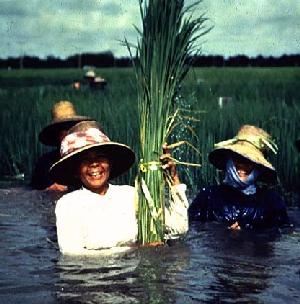
On a global basis sufficient food is produced to adequately feed everyone. Yet, the pains of hunger continue to be a common experience of many people in the world today. Food shortages in developing countries are aggravated by rapid population growth. In the last 40 years the increase in the world's population has equalled the increase that occurred from the emergence of the human race to the middle of the 20th century.
The desire for food security has adversely affected the environment. Of additional concern is the evidence of a yield growth rate stagnation in countries where the "Green Revolution" has had its greatest impact. If recent growth rates for cereal demand continue to 2025, the food need in Sub-Saharan Africa will be 2.5 times greater than production. Among the major cereals, rice is the primary staple of more than two billion people in Asia and hundreds of millions of people in Africa and Latin America. Consumption per capita varies greatly from l86 kg/year in Burma to 4 kg/year in the USA.
Today, rice is just as important to food security, or more so, than it was in 1979 when the first Director General of the International Rice Research Institute (IRRI), R. F. Chandler, made the above statement. To cope with the increasing demand for rice a key element is the development and implementation of effective rice insect management strategies. This lecture discusses the role of rice in food security and provides some background information on rice as to its taxonomic classification, origin and spread, growth stages, geographical distribution and production systems. This is followed by a discussion of the damage caused by rice insects and their management strategies.
Classification of Rice
Rice, an annual grass (Gramineae), belongs to the genus Oryza which includes twenty wild species and two cultivated species, O. sativa (Asian rice) and O. glaberrima African rice). Oryza sativa is the most commonly grown species throughout the world today. In Asia O. sativa is differentiated into three subspecies based on geographic conditions; indica, javanica, and japonica. Indica refers to the tropical and subtropical varieties grown throughout South and Southeast Asia and southern China. Javanica designates the bulu (awned) and gundil (awnless) rices with long panicles and bold grains growing alongside of indicas in Indonesia. Japonica refers to the short and roundish grained varieties of the temperate zones of Japan, China, and Korea. Japonica-type varieties are grown in northern California, USA due to their tolerance to low night temperatures. Indica-type varieties are grown in the southern USA.
Origin and Spread of Rice
Domestication of O. sativa occurred some l0,000 years ago in the river valleys of South and Southeast Asia and China. Rice specimens found in China date back to 3,000 B. C. and earliest historical Chinese writings indicate that of the five principal food plants in the country, rice was the most important.
Rice was introduced into southern Japan from China in about l00 B. C. and from there it spread reaching the extreme north of Japan only in the eighteenth century. The Portuguese introduced rice into Brazil and the Spaniards introduced rice into Central America and parts of South America.
Rice cultivation in the USA dates from about l646 when it was introduced into the James River region of Virginia and in l685 when it was first grown in the colony of South Carolina. The rice variety, "Carolina Gold" was introduced into South Carolina when a storm forced a New England ship, sailing from Madagascar, to harbor in Charleston. Before leaving the port, the captain gave the colonists about 5 kg of rice seed and that started the Carolina rice industry. Rice was introduced into Louisiana in 1718 but did not assume importance there until l887. Commercial rice production in the Sacramento Valley, California began in 1912.
The Rice Plant
The parts of a mature rice plant are illustrated in Figure 1. The rice plant consists of the roots, stem, leaves and panicle. Rice passes through the following l0 stages during its growth cycle: (l) germination and emergence, (2) seedling, (3) tillering, (4) stem elongation, (5) panicle initiation, (6) panicle development, (7) flowering, (8) milk grain, (9) dough grain, and (l0) mature grain stage. Traditional varieties require about l50 days of growth to reach the mature grain stage whereas the modern, high yielding, very early maturing varieties can be harvested in as few as 90 days after sowing.
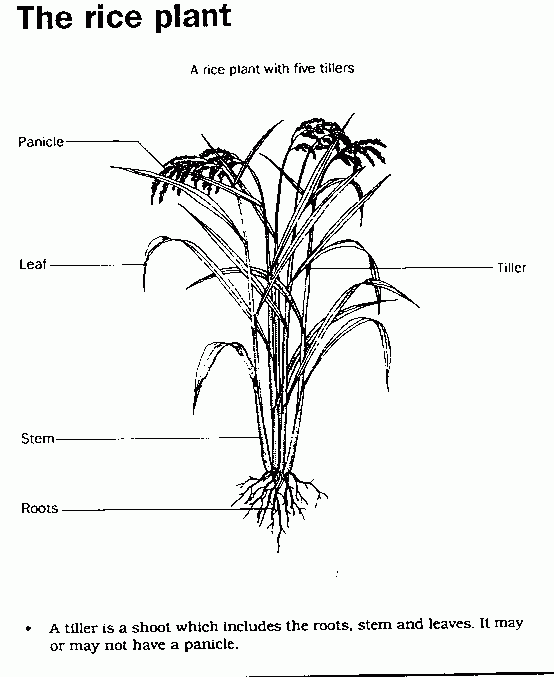
Where is Rice Grown?
Rice is cultivated from 53° N to 40° S latitude where it is adapted to a wide range of environmental conditions, from uplands to waterlogged lowlands. It is grown at high elevations, such as the rice terraces in the mountains in the Philippines (Figure 2), and at low elevations down to sea level.
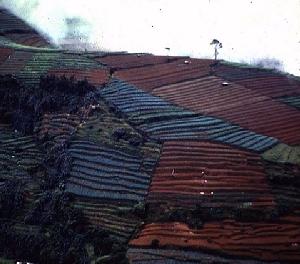
Table 1. Rice area, production and yield by world region (FAOSTAT-PC, FAO 1995).
| Region | Area harvested (000 ha) | Production(000 metric ton) | Grain yield/ha(metric ton) |
|---|---|---|---|
| South America | 5,659 | 15,295 | 2.70 |
| USA | 1,336 | 8,972 | 6.72 |
| Central America | 552 | 1,929 | 3.49 |
| Europe | 378 | 2,113 | 5.59 |
| Asia | 130,027 | 485,077 | 3.73 |
| Africa | 7,235 | 15,855 | 2.19 |
| World | 1,456,187 | 529,241 |
Rice Production Systems
There are two major systems of rice cultivation; the dry or upland system, in which the crop is grown on dry ground, the same as for wheat and other cereals; and the wet system, in which the rice land is flooded and the crop is grown in standing water from planting until near harvesting. Rice production systems more specifically classified according to ecology in terms of water are (1) upland, (2) irrigated, (3) rainfed lowland, and (4) deep water.
Upland rice is often grown in hilly areas (Figure 3) with natural rainfall and without levees to impound water. An assured rainfall over a 3 to 4 month period is necessary as the crop is rainfed and the water supply is not controlled.
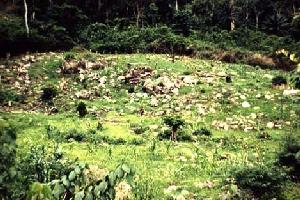
In the forest region of West Africa, prior to sowing of rice, trees, shrubs and weeds in fallow upland fields are cut and then burned. For rice plants to compete with weeds, rice seed is sown within a few days after burning. Seed is sown directly into untilled land with the aid of a hand hoe (Figure 4).
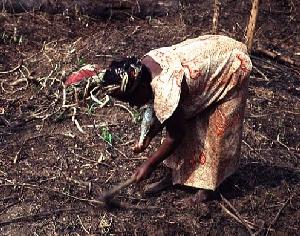
Irrigated rice is grown in fields with levees to impound water supplied principally from irrigation. Water control is more accurate than with rainfed rice and seldom exceeds 50 cm. Rainfed lowland rice is grown in standing water in fields with levees to impound natural rainfall. If rainfall is heavy, water may reach depths of 50 to 100 cm. Deep water rice is grown in the flood plains along rivers in Mali in West Africa, and India, Bangladesh and Thailand (Figure 5) in Asia. Water depth may reach several meters during monsoon rains and varieties adapted to deepwater conditions can elongate at the rate of 25 cm per day in rapidly rising water.

Irrigated, rainfed lowland (Figure 6) and deepwater rice fields are ploughed when the rainy season begins and puddled to provide a fine tilth before flooding. Seed may be either broadcast or drilled into the soil or it may be sown in nursery beds and the seedlings subsequently transplanted when they reach a suitable stage of growth (about 21 days after sowing). Rice in the USA is pregerminated and broadcast into irrigated rice fields from airplanes or drill-seeded.
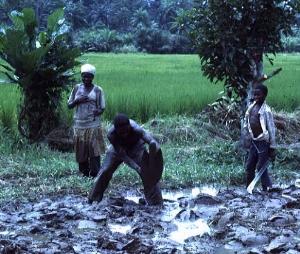
Most of the rice area in China (Figure 7) and the USA is irrigated. In Latin America and Africa most of the rice is upland.
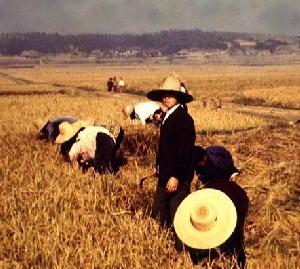
Plant Damage Caused by Rice Insects
Insect pests attack all portions of the rice plant and all stages of plant growth. Feeding guilds consist of the (1) root feeders, (2) stem borers, (3) leafhoppers and planthoppers, (4) defoliators, and (5) grain sucking insects. Insects also attack rice grains in storage.
Root Feeders
Examples of root feeders are termites (order Isoptera) and the rice water weevil, Lissorhoptrus oryzophilus (order Coleoptera). Termites, in West African upland rice fields, occur in patches and often kill the plants, especially when rainfall is lacking. The water weevil is a major insect pest of irrigated rice in the USA. The adult water weevil feeds on the leaves and causes little damage while the larvae feed on the roots and severely reduce the root system. Plants with reduced root systems grow poorly and have low yields.
Stem Borers
Stem borers consist primarily of insects in the lepidopterous families, Noctuidae and Pyralidae. The adult moths lay eggs on rice leaves and the larvae bore into the stem. Feeding in the stem during the vegetative growth stage of the plant (seedling to stem elongation) causes death of the central shoot ("deadheart"). Damaged shoots do not produce a panicle, and thus, produce no grain. Feeding of stem borers during the reproductive stage (panicle initiation to milk grain) causes a severing of the developing panicle at its base. As a result, the panicle is unfilled and whitish in color, rather than filled with grain and brownish in color. Such empty panicles are called "whiteheads". In the southern USA the sugarcane borer, Diatraea saccharalis, and the rice stalk borer, Chilo plejadellus are common stem borers attacking rice.
Leafhoppers and Planthoppers
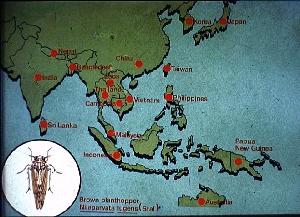
In general, the leafhoppers (family Cicadellidae) attack all aerial parts of the plant whereas the planthoppers (family Delphacidae) attack the basal portions (stems). The leafhoppers and planthoppers (order Hemiptera) are sucking insects which remove plant sap from the xylem and phloem tissues of the plant. Severely damaged plants dry and take on the brownish appearance of plants that have been damaged by fire. Hence, hopper damage is called "hopper burn". These insects are severe pests in Asia (Figure 8) where they not only cause direct damage, by removing plant sap, but are also vectors of serious rice virus diseases, such as rice tungro virus transmitted by the green leafhopper, Nephotettix virescens, and grassy stunt virus transmitted by the brown planthopper, Nilaparvata lugens.
Defoliators
A large group of insects belonging to several insect orders feed on rice leaves. Most common are the larvae and adults of beetles (order Coleoptera), larvae of the order Lepidoptera and grasshoppers (order Orthoptera). Defoliation reduces the photosynthetic capacity of the rice plant and thereby decreases yields. However, when feeding damage occurs early in rice growth, plants have an ability to compensate for damage by producing new tillers. Thus, rice plants in the actively tillering stage of growth can tolerate a certain level of leaf damage without any yield loss. An example of a coleopterous defoliator, is the adult of the rice water weevil in the USA. Foliage removal by this beetle, however, is usually minimal and below the yield reducing level. The common armyworm, Pseudaletia unipuncta (order Lepidoptera) occurs sporadically in epidemic numbers on rice in California where leaf feeding by the larvae causes yield reductions.
Grain Sucking Insects
The stink bugs (order Hemiptera), known for the foul odor produced by the scent glands on their abdomen, penetrate the developing grain with their sucking mouthparts and remove the white fluid referred to as "milk". Damage early in the development of the grain prevents the filling of the grain. Later attack results in "pecky rice" which is referred to as the condition of the grain after being sucked by stink bugs and the grain being subsequently stained by the bacteria or fungi which enter the puncture wounds. In some countries the market price of pecky rice is reduced. The stink bug, Oebalus pugnax, found in North America east of the Rocky Mountains and as far north as Minnesota, is a pest of rice in the southern USA.
Yield Losses Caused by Rice Insect Pests
Historical records from Korea and Japan report on the history of rice insect pests during the last two millennia. In 875 a migratory locust outbreak occurred in the Ise District of Japan and a brown planthopper outbreak in l733 was reported as one of the most damaging insect outbreaks in the history of rice production in Japan. About 2.6 million persons were affected and l2,000 died from hunger.
Insects reduce yields substantially, especially in tropical Asia. Cramer estimated the rice yield losses caused by insects by reviewing the literature up to l966 (Table 2). He estimated losses ranging from 31.5% in Asia to 2% in Europe. More recently, a series of experiments coordinated by IRRI and conducted in farmers' fields in six Asian countries indicated that the increase in yields of fields receiving fertilizer, and insect and weed control was 0.9 t/ha in the wet season and l.7 t/ha in the dry season; 0.4 ton and 0.6 ton of these yield increases respectively, were due to insect control. The importance of insects and other pests is indicated by the fact that only a 10% increase or decrease in food grain production, on a global scale, can make the difference between a glut and acute scarcity.
Table 2.Estimated rice yield losses caused by insect pests on a world basis (from Cramer 1967)
| Region | Yield loss (%) |
|---|---|
| Asia | 31.5 |
| People's Republic of China | 15.0 |
| Africa | 14.4 |
| South America | 3.5 |
| North and Central America | 3.4 |
| Europe | 2.0 |
Factors Affecting Extent of Insect-Caused Yield Losses in Rice
Although rice insects have been a problem through the centuries, outbreaks have increased and the insect pest complex has changed, in the last four decades. Some insects have increased in severity, whereas others have declined in importance. There is evidence that ecologically specialized (monophagous) species have been favored by crop intensification. Intensification involves changes in cultural practices such as (1) an increase in the number of crops grown per year, (2) an increase in the use of agricultural chemicals (fertilizer and pesticides), (3) increased area under irrigation, and (4) increased plant densities.
Changes in rice cultural practices have accompanied the widespread adoption of modern varieties. The photoperiod insensitivity and reduced growth duration of the modern varieties have made it possible to grow two and even three crops per year, where water, and temperatures are adequate. Continuous cropping throughout the year has caused shifts in the composition of pest fauna. Species dependent on standing water, such as the whorl maggot, Hydrellia philippina, and the rice caseworm Nymphula depunctalis, have become more abundant because of increased area under irrigation.
The most dramatic effects of modern cultural practices on abundance of rice insect specialists in Asia is seen in the plant sucking Homoptera, especially the nearly monophagous brown planthopper. The brown planthopper (Figure 8) arose from the status of a secondary pest to a major yield constraint beginning in the l960s. The increased use of resurgence-inducing insecticides, has been considered the major cause of intensified brown planthopper problems. Resurgence-inducing insecticides are selectively toxic to the predators of the brown planthopper and result in a dramatic population increase of the brown planthopper after insecticide application.
Development of Pest Management Tactics for Rice
As rice scientists and farmers have gained experience in the cultivation of the modern varieties and the agronomic practices that have accompanied the "Green Revolution" there has been a shift from a primarily unilateral approach of insect control, with a strong reliance on insecticides, to a multilateral approach involving a mix of control tactics. This approach, known as integrated pest management (IPM), in the simplest terms is referred to as "a broad ecological attack combining several tactics including biological, chemical, and cultural control methods and insect resistant rice varieties, for the economic control and management of pest populations".
IPM programs have a significant impact on minimizing the adverse effects of insecticides, and in increasing the profitability of rice production. It has been estimated that the cost savings from research leading to increased insect pest management efficiency on rice in South and Southeast Asia will be $973 million in insecticide saved by the year 2,000.
During a 1960s visit to IRRI in the Philippines Norman Cousins, then editor of the Saturday Review, wrote that "any genuine improvement in the human condition on this planet must be concerned with rice." Scientists throughout the rice growing regions of the world are striving to do their part in improving the quality of life by developing and implementing strategies to more effectively and economically manage rice insect pests. These strategies will now be discussed.
Cultural Practices
Cultural methods to control insects involve crop production practices that have a dual purpose of crop production and insect suppression. Farmers have developed these practices through many years of trial and error and these practices have been handed down through generations. Primary cultural control practices are those done specifically to control insects such as draining a field to control the aquatic caseworm larva or planting a trap crop for stem borers. Secondary practices are those that are specifically done for crop husbandry, such as land preparation and weeding, but which also happen to minimize pest buildup.
Rice culture has a rich source of folklore regarding indigenous cultural practices. Cultural control practices that offer potential control of rice insects includes (1) mixed cropping, (2) planting methods (transplanting vs direct seeding), (3) age of seedlings at time of transplanting, (4) water management, (5) fertilizer management, (6) crop rotation, (7) number of rice crops per year, (8) planting time, (9) synchronous vs asynchronous planting over a given area, (10) trap crop, (11) tillage, (12) weeding and (13) growth duration of the crop.
Chemical Control
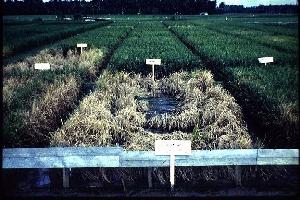
Figure 9. Resurgence of the brown planthopper. The "hopper burned" plot in the foreground has been treated with insecticides while the healthy plot behind it has not been treated.
When modern rice varieties were introduced in the 1960's, insecticides were one component in a package of technologies of the "Green Revolution" in Asia. Chlorinated hydrocarbons were first used, then phosphates, and recently the carbamates have been used. However, insecticides are often too expensive for resource-poor farmers to use. Even where farmers can afford insecticides the health hazards may outweigh the economic benefits. Studies in the Philippines have indicated that when the effect on farmers health and subsequent lost days of work, and the adverse effect on the environment are taken into consideration, the productivity increases obtained from the utilization of insecticides are minimal. Due to their cost, toxicity to man and the environment, the secondary pest problems caused such as the resurgence of the brown planthopper (see Figure 9), and because of the development of insecticide resistant populations, the recent trend in rice IPM has been toward the integration of insect resistant varieties with the conservation of natural control agents. Although there are cases where the judicious use of selective insecticides in rice is necessary, routine, calendar-based applications in a non-IPM context are no longer recommended.
Biological Control
The action of indigenous predators, parasitoids and insect pathogens forms the cornerstone for modern IPM programs on rice. Although hundreds of insect species feed on rice only 8% are considered as major pests. This indicates that over the thousands of years of rice cultivation a relatively stable association between rice insects and their natural enemies has evolved. When this stability is upset, as is the case in the destruction of predators by insecticides, insect outbreaks occur (see Figure 9).
Classical and inundative biological control approaches tried so far have had little success in rice. However, research studies have shown that indigenous natural enemies have a strong impact on rice pest populations and their conservation is an essential part of rice IPM programs. Many species of predators, parasitoids and pathogens have been shown to attack rice insect pests. However, only one example of each will be mentioned.
Parasitoids
Numerous parasitoids have been reported attacking the eggs, larvae and pupae of the rice leaffolder, Cnaphalocrocis medinalis in Asia. Larval parasitism averaged 40% in studies conducted on the IRRI research farm, and in nearby farmers' fields in the Philippines (Figure 10). From 4,904 larvae collected, 15 species of parasitoids, belonging to 9 families, were found.
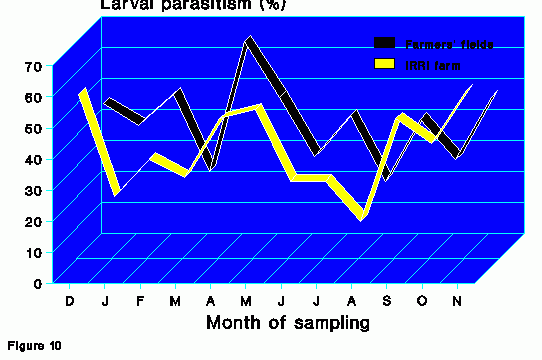
Predators
Predacious arthropods, including insects and spiders, attack all stages of rice insects. Spiders are abundant in rice fields throughout the world. The wolf spider, Lycosa pseudoannulata (Figure 11) is probably the most important predator in rice fields in Asia. The diet of the wolf spider depends on the types of insects that are available but leafhoppers and planthoppers are the major prey. Lycosa feeds on both hopper nymphs and adults and is considered to be a major regulator of brown planthopper populations. One wolf spider can eat up to 45 hoppers per day.
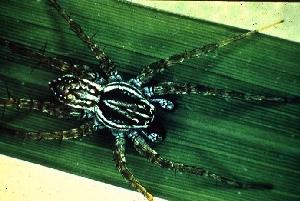
Pathogens
Pathogens belonging to the fungi, bacteria and virus groups attack rice insect pests and play an important role in the regulation in rice insect pest populations. Among the entomogenous fungi, Metarhizium anisopliae, the "green muscardine fungus", is a common insect pathogen. Metarhizium anisopliae commonly attacks rice planthoppers, leafhoppers and rice black bugs, Scotinophara sp. A dead black bug, covered by white mycelia of M. anisopliae, is shown in Figure 12.
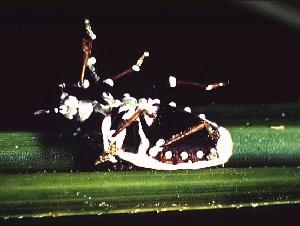
Plant Resistance to Insects
Resistant cultivars are sought as the major tactic in an integrated approach to rice insect control. Incorporation of insect resistance into modern varieties is a major objective of most rice breeding programs in developing countries because:
- income per hectare in rice production is relatively low and
- money spent for controls, such as insecticides, significantly lowers profits,
- resistance in rice cultivars is essentially free to the farmer,
- insecticides cause accidental poisoning accidents and pollute the environment,
- land holdings of most rice farmers are small and thus maintaining
- insecticide application equipment is not economical, and
- varietal resistance is generally compatible with other control tactics.
Because of its unique advantages host plant resistance is sought after as a key tactic in the integrated control of rice insect pests in developing countries. The identification of insect resistant rice germplasm and its use in the breeding of high yielding varieties with resistance to multiple stresses has been an integral part of the of the success of the "Green Revolution" and has increased the profitability of rice production, minimized safety risks to farmers, and contributed to a more healthful environment.
Evaluation of Rice Germplasm for Insect Resistance
It has been estimated that the number of rice cultivars in collection may reach 120,000. The IRRI International Rice Germplasm Center, established in 1961, has about 80,000 accessions of O. sativa, 2,408 strains of O. glaberrima and 2,214 wild species and species-hybrids. This collection is the world's largest repository for a single crop. To provide extra security for the IRRI collection the institute deposits a duplicate set of seed in the U.S. National Seed Storage Laboratory, Fort Collins, Colorado, USA.
Methods to screen the germplasm collection to identify insect resistant cultivars for use as donors in the breeding programs have been developed for more than 30 rice insect species throughout the world. In Asia and South America major emphasis has been on the leafhoppers, planthoppers and stem borers. In the USA, major emphasis has been on the rice water weevil.
Breeding Insect Resistant Rice Varieties
Breeding for insect resistance has only been a focus of rice development programs since the early 1960s. Although rice breeding programs throughout the world have developed and released commercial varieties with resistance to numerous insect species, emphasis in this section will be primarily on the brown planthopper as a typical example.
All of the major rice producing countries in South and Southeast Asia have breeding programs to control this pest. Rice cultivars resistant to the brown planthopper were first identified at IRRI in 1963. Since 1963 about 50,000 accessions have been tested and more than 400 resistant accessions have been identified.
Seven genes have been identified that impart resistance to the brown planthopper; Bph 1, bph 2, Bph 3, bph 4, bph 5, Bph 6 and bph 7. IR36, once the most widely grown rice variety in the world has multiple resistance to several diseases and insects, including the brown planthopper, good grain quality, and high yield potential.
Insect Resistant Cultivars as a Component in IPM Systems
Insect resistant varieties are being successfully utilized, as a major component in rice IPM. IPM programs utilize biological controls, traditional cultural controls, insecticides and pest resistant varieties to varying degrees. The cornerstone of the Indonesian rice IPM strategy is the use of multiple pest resistant varieties in a mix with natural biological control and other control tactics. Examples of how insect resistant varieties can be integrated with biological, cultural and chemical control are now presented.
Plant Resistance to Insects and Biological Control
Insect resistant varieties may have an adverse effect on natural enemies by reducing prey density, but they are generally considered to be compatible with biocontrol agents. The combination of multiple pest resistance and natural biological control, is especially attractive in developing countries in the tropics where extension services are often not able to train farmers in IPM principles and practices. Pest resistant varieties shift the pest:predator ratio in favor of biological control. In field studies in the Philippines, brown planthopper: spider ratios decreased with an increase in the level of resistance.
Host plant resistance enhances predatory activity in a manner which may be synergistic. Predation rate of the wolf spider increases when the spider preys on brown planthopper adults on resistant cultivars. The mechanism involved is believed to be the restless nature, and subsequent frequent movement of the brown planthoppers on the resistant variety, which exposes them to a greater degree to detection by the spider.
Combinations of host plant resistance and predation by the mirid bug, Cyrtorhinus lividipennis have a cumulative effect on the population increase of the green leafhopper, Nephotettix virescens, a vector of the dreaded tungro virus. In cage studies the number of leafhoppers only reached 6 on leafhopper resistant IR29, with the predator, and 31 without the predator, while there were 91 and 220 leafhoppers respectively on susceptible IR22 (Figure 13).

Plant Resistance to Insects and Cultural Control
Most cultural practices are considered to integrate well with other control tactics in IPM systems, and the use of resistant varieties, combined with good cultural management, is considered to be a powerful tool in managing pests. Examples of integration are resistant varieties plus (1) fertilizer management, and/or (2) pest evasion techniques.
Increased amounts of nitrogen fertilizer has been one of the major components contributing to the high yields of modern crop cultivars. However, high plant nitrogen levels, are generally favorable to pest insect populations. Results of a study indicated that nitrogen fertilizer favors brown planthopper population growth, regardless of the level of resistance in the host plant, but the population increase is least at the higher levels of resistance, such as on highly resistant IR60.
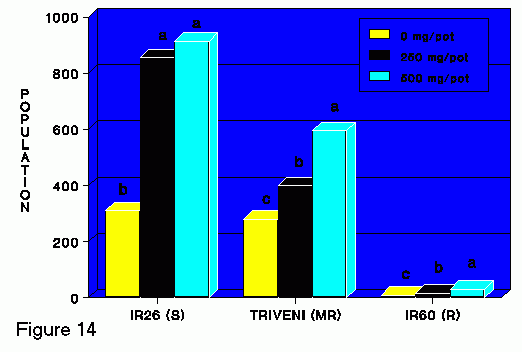
Cultural practices employed to evade pest attack include early maturing varieties which are harvested before the pest reaches damaging populations. Brown planthopper: predator ratios on early maturing rice varieties are lower than those on late maturing varieties. Incorporation of even moderate levels of brown planthopper resistance into early maturing varieties enhances the level of protection against this pest.
Plant Resistance to Insects and Chemical Control
Because of the weakened physiological condition of insects feeding on resistant varieties control of the surviving insects with insecticides is more effective, when pests are on resistant, than when they are on susceptible, varieties. Brown planthopper mortality, when reared on either a moderately resistant (ASD7), or a highly resistant (Sinna Sivappu) rice variety, is higher than when feeding on a susceptible (TN1) variety (Figure 15).
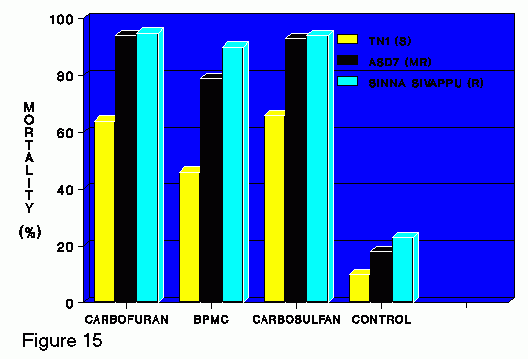
Another interaction of host plant resistance and insecticides is the relationship between level of resistance and insecticide-induced, brown planthopper resurgence. Brown planthopper populations on a resistant rice variety treated with a resurgence-inducing insecticide only reached 10 insects per plant, whereas the population on a treated susceptible variety was 1,100 per plant. Thus, when insects other than the brown planthopper reach populations above the economic threshold, and require insecticide treatment, the level of brown planthopper resurgence can be reduced, by planting a brown planthopper resistant variety.
Development of "Biotypes" on Insect Resistant Rice Varieties. Insect populations have a wide range of genetic variability that maximizes their fitness in the presence of genetic diversity of host plants. The widespread planting of one rice variety (monocrop) that has been commonplace since the "Green Revolution" has significantly decreased the genetic diversity of rice plants. As a result, some rice insect species have overcome the resistance of certain rice varieties. Such apparently new forms of pests have been termed 'biotypes' which refers to a population of insects that is capable of damaging plant varieties that are resistant to other populations of the same species.
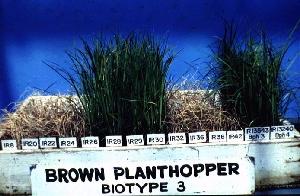
Brown planthopper biotypes have been a very severe problem in South and Southeast Asia. IR26 with the Bph 1 gene for resistance was the first brown planthopper resistant variety released by IRRI in 1974. Within the Philippines, brown planthopper outbreaks were observed in IR26 after 2 to 3 years of commercial cultivation (approximately 6 crops) as the result of a selection of a strain that could feed on IR26 (biotype 2). Resistant varieties released subsequently to IR26 have also succumbed to biotype selection within a few years after release as indicated in Figure 16 which shows the reaction of varieties IR32, IR36 and IR38 (with the bph 2 gene for resistance) to brown planthopper biotype 3 in greenhouse feeding tests.
To cope with the brown planthopper biotype problem several gene deployment strategies have been proposed to increase the stability of insect resistant varieties. These strategies are (1) sequential release where a variety with a single major resistance (R) gene replaces a variety with an R gene that has been overcome by the selection for a virulent biotype, (2) gene pyramiding, the incorporation of two or more major R genes into the same variety to provide resistance to two or more biotypes, (3) horizontal resistance, a type of resistance that is expressed equally against all biotypes, (4) gene rotation, a strategy where varieties with different R genes are used in different cropping seasons to minimize selection pressure on given resistance genes, and (5) geographical deployment, the planting of varieties with different R genes in adjacent cropping areas.
Use of Biotechnology
Developing Insect Resistant Rice Varieties. Recent advances in biotechnology provide the possibility of solving some of the constraints that have limited the practical use of genetic resistance to insects in pest management programs. Biotechnology provides new possibilities of manipulating germplasm.
Wide hybridization. Wide hybridization is a plant breeding tool for the incorporation of alien genetic variation from wild species of Oryza into commercially useful cultivars. Wild rice species are a rich source of R genes for use in breeding programs for insect resistance. The IRRI breeding program has utilized the wild rice species O. brachyantha in the development of crosses with O. sativa in the development of brown planthopper resistance. Some progeny are resistant to all known biotypes of the brown planthopper.
Genetic Transformation. IRRI scientists in cooperation with the Rockefeller Foundation Biotechnology Network are incorporating novel genes for resistance into rice through transformation. Genes, such as the Bt (Bacillus thuringiensis) gene coding for toxic proteins, inhibitors of digestive enzymes such as protease inhibitors, and ribosome inactivating genes are being transferred to rice.
Insect Resistant Cultivars and Control of Non-insect Pests
There are a myriad of interactions among the various pests (insects, diseases, nematodes, rodents, and weeds) that attack rice plants. The control of a target pest may cause population increases, or decreases, or may not affect another pest.
Weeds and plant diseases may be adversely affected by the planting of insect resistant varieties. Insects that feed on susceptible seedlings and plants, in the vegetative stage, slow rice plant growth and reduce the plant foliage area. This causes the closing of the plant canopy to be delayed and reduces the competition for light and nutrients which in turn allows greater weed growth.
Insect feeding predisposes rice plants to attack of bacterial and fungal pathogens that invade the insect-damaged plant tissue. Some insect species, especially the leaf- and planthoppers, are rice virus vectors. Decrease in the feeding activity on non-preferred rice varieties decreases the incidence of virus infection.
Utilization of Insect Resistant Rice Varieties
Host plant resistance has served as a key component in IPM programs and in the development of sustainable rice production systems. National rice research programs in many countries have made significant progress in the development and release of pest-resistant varieties. It would be difficult to cover in detail all of these programs so we will limit our discussion to the program at IRRI in the Philippines.
IRRI's rice improvement program has placed major emphasis on developing germplasm with multiple resistance to key diseases and insects. The widespread adoption of such varieties has helped to stabilize rice production in Asia. As Figure 17 indicates, the yield of insect and disease susceptible IR8 fluctuates significantly from year to year depending on disease and insect pressure and shows a gradual, mean decline over 20 years. When new varieties with multiple resistance are introduced there are only minor fluctuations in yield, as these varieties have greater yield stability . An estimate of the contribution of host plant resistance to maintain yield is given in Figure 17. Yields of the original high-yielding varieties such as IR8 would have declined an average of 1.3% per year, or a total of 2 t/ha over a 20-year period without crop improvement to incorporate multiple pest resistance. The sequential release of varieties with diverse genes is necessary to cope with the development of new races and biotypes of diseases and insects respectively.

Modern varieties have rapidly spread in the major rice growing countries and have had a significant economic and social impact. In the Philippines, 94% of the area is planted to modern varieties, and modern varieties occupy 100% of the rice area in China Japan and the USA. Variety IR36 with multiple resistance to insects and diseases was once grown on about 16 million ha in Asia. The availability of rice varieties with multiple resistance to insects and diseases has stabilized yields, increased farmer income, minimized the need for pesticides and has promoted the adoption of IPM practices.
References
- Chang, T. T. l976. The origin, evolution, cultivation dissemination and diversification of Asian and African rices. Euphytica 25: 425-441.
- De Datta, S. K. 1981. Principles and Practices of Rice Production. John Wiley, New York.
- Grist, D. H. l975. Rice. Fifth ed., Longman, London.
- Heinrichs, E. A. [ed.]. 1988. Plant Stress-Insect Interactions. Wiley, New York.
- Heinrichs, E. A. [ed.]. 1994. Biology and Management of Rice Insects. Wiley Eastern, New Delhi.
- Heinrichs, E. A. 1994. Development of multiple pest resistant crop cultivars. J. Agric. Entomol. 11: 225-253.
- Heinrichs, E. A., F. G. Medrano and H. R. Rapusas. 1985. Genetic Evaluation for Insect Resistance in Rice. International Rice Research Institute, Los Baños, Philippines.
- Heinrichs, E. A. and T. A. Miller. 1991. Rice Insects: Management Strategies. Springer-Verlag, New York.
- Heinrichs, E. A., H. R. Rapusas, G. B. Aquino and F. Palis. 1986. Integration of host plant resistance and insecticides in the control of Nephotettix virescens (Homoptera: Cicadellidae), a vector of rice tungro virus. J. Econ. Entomol. 79: 437-443.
Heinrichs, E. A., and O. Mochida. l984. From secondary to major pest status: the case of insecticide-induced rice brown planthopper, Nilaparvata lugens, resurgence. Prot. Ecol. 7: 201-218. - Kartohardjono, A. and E. A. Heinrichs. 1984. Populations of the brown planthopper, Nilaparvata lugens (Stål) (Homoptera: Delphacidae), and its predators on rice varieties with different levels of resistance. Environ. Entomol. 13: 359-365.
- Khush, G. S. 1995. Modern varieties--their real contribution to food supply and equity. Geojournal 35: 275-285.
- Reissig, W. H., E. A. Heinrichs, J. A. Litsinger, K. Moody, L. Fiedler, T. W. Mew and A. T. Barrion. l986. Illustrated Guide to Integrated Pest Management in Rice in Tropical Asia. International Rice Research Institute, Los Baños, Philippines.
- Shepard, B. M., A. T. Barrion and J. A. Litsinger. 1987. Friends of the Rice Farmer: Helpful Insects, Spiders, and Pathogens. International Rice Research Institute, Los Baños, Philippines.
- Swaminathan, M. S. l984. Rice. Scientific American 250(1): 81-93.
- Tribe, D. 1994. Feeding the Greening World. The role of international agricultural research. CAB International, Wallingford, UK.
- Way, M. and K. L. Heong. 1994. The role of biodiversity in the dynamics and management of insect pests of tropical irrigated rice - a review. Bull. Entomol. Res. 84: 567-587.